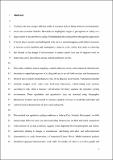| dc.contributor.author | Manton, Richard | |
| dc.contributor.author | Rau, Henrike | |
| dc.contributor.author | Fahy, Frances | |
| dc.contributor.author | Sheahan, Jerome | |
| dc.contributor.author | Clifford, Eoghan | |
| dc.date.accessioned | 2019-03-26T15:28:03Z | |
| dc.date.available | 2019-03-26T15:28:03Z | |
| dc.date.issued | 2016-01-04 | |
| dc.identifier.citation | Manton, Richard, Rau, Henrike, Fahy, Frances, Sheahan, Jerome, & Clifford, Eoghan. (2016). Using mental mapping to unpack perceived cycling risk. Accident Analysis & Prevention, 88, 138-149. doi: https://doi.org/10.1016/j.aap.2015.12.017 | en_IE |
| dc.identifier.issn | 0001-4575 | |
| dc.identifier.uri | http://hdl.handle.net/10379/15058 | |
| dc.description.abstract | Cycling is the most energy-efficient mode of transport and can bring extensive environmental, social and economic benefits. Research has highlighted negative perceptions of safety as a major barrier to the growth of cycling. Understanding these perceptions through the application of novel place-sensitive methodological tools such as mental mapping could inform measures to increase cyclist numbers and consequently improve cyclist safety. Key steps to achieving this include: (a) the design of infrastructure to reduce actual risks and (b) targeted work on improving safety perceptions among current and future cyclists.This study combines mental mapping, a stated-preference survey and a transport infrastructure inventory to unpack perceptions of cycling risk and to reveal both overlaps and discrepancies between perceived and actual characteristics of the physical environment. Participants translate mentally mapped cycle routes onto hard-copy base-maps, colour-coding road sections according to risk, while a transport infrastructure inventory captures the objective cycling environment. These qualitative and quantitative data are matched using Geographic Information Systems and exported to statistical analysis software to model the individual and (infra)structural determinants of perceived cycling risk.This method was applied to cycling conditions in Galway City (Ireland). Participants' (n = 104) mental maps delivered data-rich perceived safety observations (n = 484) and initial comparison with locations of cycling collisions suggests some alignment between perception and reality, particularly relating to danger at roundabouts. Attributing individual and (infra)structural characteristics to each observation, a Generalised Linear Mixed Model statistical analysis identified segregated infrastructure, road width, the number of vehicles as well as gender and cycling experience as significant, and interactions were found between individual and infrastructural variables. The paper concludes that mental mapping is a highly useful tool for assessing perceptions of cycling risk with a strong visual aspect and significant potential for public participation. This distinguishes it from more traditional cycling safety assessment tools that focus solely on the technical assessment of cycling infrastructure. Further development of online mapping tools is recommended as part of bicycle suitability measures to engage cyclists and the general public and to inform 'soft' and 'hard' cycling policy responses. (C) 2015 Elsevier Ltd. All rights reserved. | en_IE |
| dc.description.sponsorship | This research was funded by NUI Galway through the College of Engineering & Informatics Postgraduate Fellowship Scheme and by NUI Galway Students’ Union through the Explore Innovation Initiative. | en_IE |
| dc.format | application/pdf | en_IE |
| dc.language.iso | en | en_IE |
| dc.publisher | Elsevier | en_IE |
| dc.relation.ispartof | Accident Analysis And Prevention | en |
| dc.rights | Attribution-NonCommercial-NoDerivs 3.0 Ireland | |
| dc.rights.uri | https://creativecommons.org/licenses/by-nc-nd/3.0/ie/ | |
| dc.subject | Cycling | en_IE |
| dc.subject | Perceived risk | en_IE |
| dc.subject | Safety | en_IE |
| dc.subject | Mental mapping | en_IE |
| dc.subject | TRAVEL BEHAVIOR | en_IE |
| dc.subject | BICYCLE INFRASTRUCTURE | en_IE |
| dc.subject | PERCEPTIONS | en_IE |
| dc.subject | SAFETY | en_IE |
| dc.subject | ATTITUDES | en_IE |
| dc.subject | WALKING | en_IE |
| dc.subject | EXPERIENCES | en_IE |
| dc.subject | LANDSCAPE | en_IE |
| dc.subject | DUBLIN | en_IE |
| dc.subject | MODELS | en_IE |
| dc.title | Using mental mapping to unpack perceived cycling risk | en_IE |
| dc.type | Article | en_IE |
| dc.date.updated | 2019-03-22T16:36:45Z | |
| dc.identifier.doi | 10.1016/j.aap.2015.12.017 | |
| dc.local.publishedsource | https://doi.org/10.1016/j.aap.2015.12.017 | en_IE |
| dc.description.peer-reviewed | peer-reviewed | |
| dc.contributor.funder | College of Engineering and Informatics, National University of Ireland, Galway | en_IE |
| dc.contributor.funder | Explore Innovation Initiative, NUI Galway Students’ Union | en_IE |
| dc.internal.rssid | 10681210 | |
| dc.local.contact | Eoghan Clifford, Room 1035, Alice Perry Engineering Building, Nui Galway, Galway. 2219 Email: eoghan.clifford@nuigalway.ie | |
| dc.local.copyrightchecked | Yes | |
| dc.local.version | ACCEPTED | |
| nui.item.downloads | 680 | |


